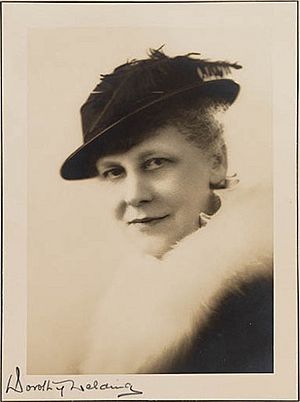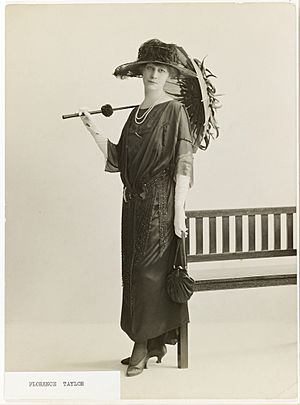Florence Mary Taylor facts for kids
Quick facts for kids
Florence Mary Taylor
|
|
|---|---|

Florence Taylor
|
|
| Born | 29 December 1879 Bedminster, Somerset, England
|
| Died | 13 February 1969 (aged 89) Potts Point, New South Wales, Australia
|
| Nationality | Australian |
| Occupation | Architect |
| Practice |
|
Florence Mary Taylor was a truly amazing Australian woman. She was born in England on December 29, 1879, and passed away in Sydney, Australia, on February 13, 1969.
Florence achieved many "firsts" in her life. She was the first woman in Australia to become a qualified architect. She was also the first Australian woman to fly in an airplane in 1909. Later, in 1926, she became the first female member of a big engineering group in the UK.
However, Florence is most famous for her work as a publisher, editor, and writer. She and her husband, George, started important magazines for the building industry in 1907. After George passed away in 1928, Florence continued to run and grow their business until she retired in 1961.
Contents
Florence Taylor's Early Life
Florence Taylor was born in Bedminster, England. Her parents, John and Eliza, were working-class people. Her father was a stone quarryman and her mother was a washerwoman.
When Florence was a child, her family moved to Australia in 1884. They first lived in Queensland for a short time, then settled in Sydney. Her father found work as a draftsman, which is someone who draws detailed plans.
Florence went to a public school near her home. She later said that she received a "good education" there.
Florence Taylor's Career Journey
After her mother passed away in 1896 and her father in 1899, Florence needed to find work. She had to support herself and her two younger sisters. She found a job as a clerk in an architect's office in Parramatta.
Florence noticed that the people who drew plans in the office earned much more money than she did. This inspired her to enroll in night classes at the Sydney Technical College. In 1904, she became the first woman to finish the final year of architecture studies there.
Becoming an Architect
During her architecture course, Florence worked for an architect named Edward Skelton Garton. She remembered him as a good mentor. However, she also recalled that other people in the office were not very encouraging.
After finishing her training, she worked for a well-known architect, John Burcham Clamp. Florence said she became his chief draftsperson. Clamp strongly supported her when she tried to become the first woman member of the NSW Institute of Architects.
In 1907, Florence applied again to join the Institute of Architects of New South Wales. At first, she was not accepted. She believed some male members did not want a woman to join. Later, after some changes, she became the first woman associate member. She became a full member in 1923.
Marriage and Flying Firsts
In April 1907, Florence married George Augustine Taylor in Sydney. George was an artist, inventor, and craftworker. He had been one of her teachers at college.
On December 5, 1909, Florence made history. She became the first Australian woman to fly in an airplane! It was a glider built by her husband, George. They flew it from the sandhills near Sydney.
Both Florence and George were very passionate about architecture and town planning. They had many other interests too. One writer called them "possibly the most amazing couple in Australia's history."
Publishing Success
Just a few months after their wedding, Florence and George started a publishing company. It was called Building Publishing Co. Ltd. They focused on magazines for the building industry.
Their main magazine was called Building. Florence also edited three other magazines: Harmony, Young Australia, and the Australian Home. These magazines covered many topics, including how gardening was part of good design.
The Taylors lived in Cremorne for some years, in a house designed by Henry Austin Wilshire. Later, they moved to an apartment in Sydney where their publishing business was also located. In 1913, they helped start the Town Planning Association of New South Wales. Florence was its secretary for many years.
Leading the Business
George Taylor passed away suddenly in 1928. Florence took over their publishing business. She had to close eight of their eleven magazines. However, she kept Building, Construction, and the Australasian Engineer going. She edited them herself and made them even bigger after World War II.
Florence continued to create town plans. She also traveled to Asia, the Americas, and Europe. She brought back new ideas about town planning, which she shared in her writings and speeches. In 1959, she published a book about her town plans.
Florence was recognized for her achievements. She was given the award of Officer of the Order of the British Empire in 1939. In 1961, she was made a Commander of that order.
Retirement and Passing
Florence Taylor retired in 1961 when she was 81 years old. She lived in Potts Point, Sydney. She passed away there on February 13, 1969.
Florence Taylor's Legacy
Florence Taylor often said that she designed up to 100 houses in Sydney between 1900 and 1907. While it's hard to find exact records for all of them, some of her design work has been discovered.
In 1907, she worked on the basement of the Farmers Department store in Sydney. This might be one of the first times a woman helped design a large commercial building in Sydney. That same year, she won prizes for her architectural designs at an exhibition in Melbourne. Her winning kitchen design was published in a magazine.
Later research has found houses likely designed by Florence in Cremorne and Roseville.
Impact on Town Planning
Florence's impact on town planning is even greater. Throughout her career, she created many town planning ideas. These were published in her magazines and in her book, Fifty years of town planning with Florence M. Taylor.
Many of her ideas for Sydney have actually happened in recent years. These include a tunnel under the harbor and more apartments in areas like Woolloomooloo. She also pushed for more flexible shopping hours and for planting more trees.
However, some of her ideas were not popular or turned out to be incorrect. For example, she wanted to tear down the Hyde Park Barracks. She also thought the Sydney Opera House would not be successful.
Other Contributions and Recognition
Florence was also involved in many clubs and groups. These included the Arts Club, the Aero Club, and the Society of Women Writers.
The suburb of Taylor in Canberra was named after her. Several awards for building and architecture are also named in her honor. These include the 'Florence M. Taylor Medallion' and the 'Florence Taylor Award'. A street in Canberra, Florence Taylor Street, is also named for her.
In 1930, Florence also created the George A. Taylor Memorial Medal. This medal is given each year to the winner of a building construction prize for students.
A book about her life, Florence Taylor's Hats: Designing, Building and Editing Sydney, was published in 2008.
A large portrait of Florence Taylor can be seen on an apartment building near Sydney's Central railway station. It honors her as "Australia's first woman architect."
In 2019, a new magazine called 'Florence' was launched. It is "dedicated to women working in, and contributing to the construction industry." The magazine states that Florence Taylor was its "inspiration."
A portrait of Florence Taylor by Jerrold Nathan is kept at the Mitchell Library in Sydney.
Awards
Florence Mary Taylor was added to the Victorian Honour Roll of Women in 2001.
See also
 In Spanish: Florence Mary Taylor para niños
In Spanish: Florence Mary Taylor para niños


